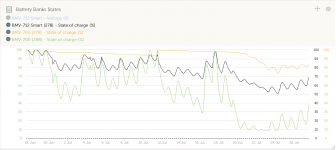nabsim
Full Member
- Messages
- 4,194
I thought the idea was the charger goes onto the lead acid technology so you didn’t need a Lifepo4 profile Ken? Saying that in a lot of cases a gel profile is close enough. If charger goes to Lifepo4 using a Lifepo4 profile it makes more sense to me but I still don’t get how it can fully charge either agm or gel lead carbon faster. Will have to wait and see if David can get it through my headi am poor on knowledge it’s all electrickery to me but as i understand it the lithium charges fast and is used in the first instance but also constantly trickle charges the lead element , i’m not a big power user very rarely turn on tv but run my fridge freezer for several hours a day off inverter, lpg wise i probably use less than a ltr a day in the summer and double that in the winter

